Personal Climate Resilience: The Underground Greenhouse
This is a follow-up from conversations here on c99 on runaway climate change. "Um, G, tell me you're not a nutbar survivalist." No. Well, not yet :=) I'll write more later on the various options or levels of personal sustainability for climate change. Here is a follow-up on structures for growing plants year-round in a climate-controlled greenhouse (in an economical and fairly low-tech manner.) There are a number of existing technologies. Our family has chosen the underground greenhouse as a forthcoming project. Saving up every loose penny! I've got lots of photos and some links below.
Russ Finch's Greenhouse In The Snow

Winter view from the Northeast
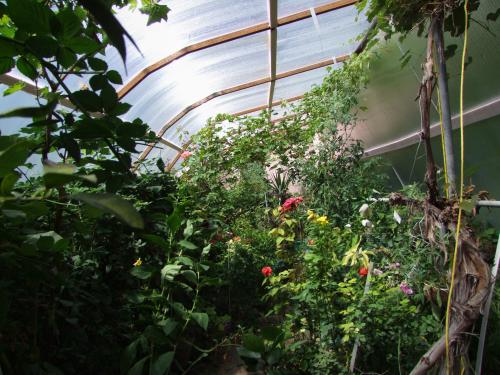
Winter view from the Inside
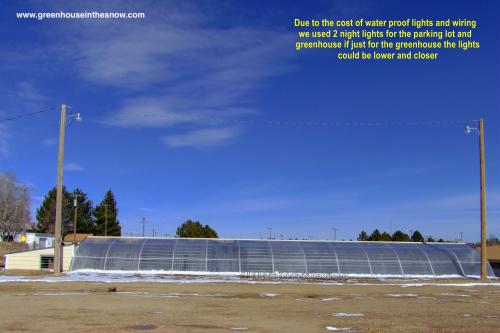
South side view
This is what's doable today. A Nebraska farmer named Russ Finch grows fabulous citrus fruits through the winter to sell at local farmers markets. In an underground greenhouse he had designed and built himself. As of 2015, Mr. Finch has built one for a local school and there are 17 of his greenhouses in the U.S. and six in Canada. All the underground greenhouse photos here are from him. His site link is http://greenhouseinthesnow.com/index.html
It sure looks good, eh. Some administrative points before we look at the structure more closely.
* "I'm no expert, but..." Our family decided on this design last year and we've bought the plans to build it. We presently live in a village and are hoping to sell and buy a rural acreage next summer. Our housing market is lousy and we couldn't sell before, but we're now willing to take a big capital loss. (F*ck 'em if they can't take a joke :=) Two of our young adult kids are coming to live with us next month to help us prep, sell, and then move to an affordable acreage further north, where they' and their young friends will help us build this design. Please don't confuse me with an expert.
* "I have had no financial relations with that man!" I admire Mr Finch and prefer his design, but I'm not flogging it here. I'm just showing his work as the best example we know of. I'd be real happy to learn more about better designs.
* "I have no idea even where to begin." No, really. If I say something that makes no sense, let me know so I could back up the truck a bit about that point.
Well then. Let's cover in this article some of the passive solar design principles used in the underground greenhouse. If folks are interested in more detail, I could do a second article on construction and materials. Mr Finch wouldn't be happy with giving away his work, but we could talk about general construction and material principles. Then you could contact him and purchase his design plans on his website.
The structure follows the designs of passive solar knowledge that folks used to know before "cheap" energy allowed them to build structures willy-nilly, anyhow they wanted, without regard to any concerns of energy, environment, or even psychology. During the 70s, the back-to-the-land folks and other counter-culture groups rediscovered the principles of passive solar design, encouraged by our first Green President, Jimmy Carter, my hero, who knows a thing or two about building construction. Sadly, the sick, conservative 80s shut that knowledge down. So, here are three principles of passive solar design that feature in the underground greenhouse:
1. In the Northern hemisphere, the structure should face south
The vast majority of house builders face the house towards the street. It is logical, eh? Not for optimizing passive solar features. The point of passive solar gain is to take advantage of the local climate. In the Northern hemisphere the sun is always to the south; lower in winter and higher in summer. In the winter, the objective is to capture that sunlight and in the summer to be shielded from it. That can't be done, for example, if the structure faces west and the narrow side faces south, usually without a window. Or, heaven forbid, the house faces north with most of its windows into the prevailing cold weather patterns.
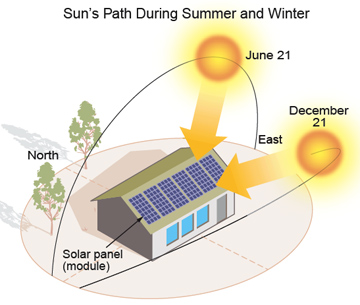
Source: http://thesolarplanner.com/array_placement.html
As winter solstice (21 December) approaches, the angle at which the sun rises and sets progressively moves further toward the south and the daylight hours will become shorter. In summer the sun will rise and set further toward the north as the summer solstice (21 June ) approaches and the daylight hours will lengthen.
So the underground greenhouse is sited north-south according to the site's latitude co-ordinates. See the photos above.
2. The saltbox roof shape
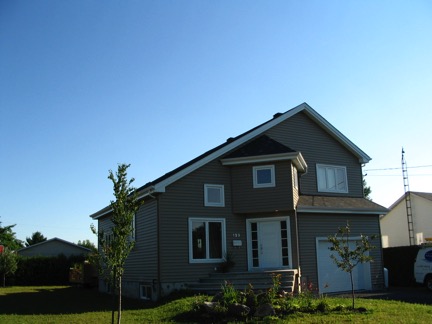
Source: personal photo
I took this photo on a walk late one afternoon, just as an illustration of the salt box roof shape. Another way of seeing it is that it looks like an RV (caravan for southerners) design. Consider a house design. The long slope faces to the north, so that the cold winter winds would flow up and over the house. The south-facing front has the large windows and the roof slope can hold PV panels facing into the sun. Thereafter, on the inside, an open floor plan would aid passive solar features. Place less used spaces to the north/rear of the building and spaces requiring heat and light to the south/front.
The underground greenhouse uses the salt box shape and interior passive design principles, as you would notice in the photos.
3. Design for passive solar heating
Let's discuss only direct gain features. Two things are needed for passive solar heating: large, south-facing windows and thermal mass. The windows let in heat and light and the thermal mass absorbs it and radiates it outward when the house cools down. The thermal mass materials in the house are items such as masonry floors and walls. Thermal mass can be obtained from a variety of materials: concrete, tiles, masonry, wood, etc. and used on the floor and walls.
The underground greenhouse uses these two passive solar heat features.
Large, south-facing "windows"
The first photo shows the ridged polycarbonate sheets that let in the south-side sunlight.

The second shows a more complete view.
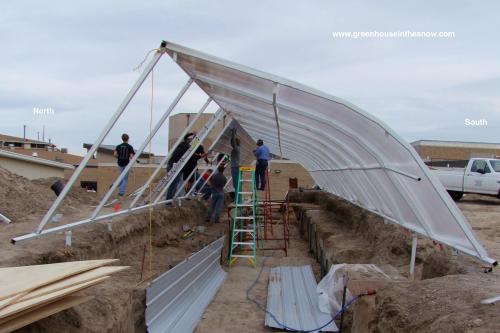
Thermal mass
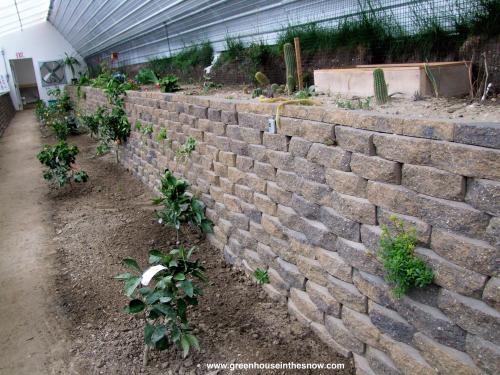
In his underground greenhouse, Mr Finch uses the rear North Wall to reflect incoming sunlight downward into the growing space. At the rear base, he built in a brick construction that does several jobs. It creates the "basement" foundation wall. It acts as thermal mass to absorb daylight and radiate the heat during the night. And it creates another growing space above it. Mr Finch grows all kinds of citrus fruit against this rear brick wall.
The other two passive solar design principles that are important to me are: design for passive cooling, and, the design of windows. In the underground greenhouse, Mr Finch uses geothermal pipes for climate control, as well as fans on the short sides on the east and west walls. Regarding "window" design, he likes a double wall of ridged polycarbonate. More on that in a later discussion of material, dimensions, siting, and construction issues. If you wish.
Here are some other resources.
An oldie but a goodie is the book The Ecological House by Robert Butler. It helped me grasp some passive solar design principles and all sorts of other stuff.
It's on Amazon: http://www.amazon.com/Ecological-House-Robert-Brown-Butler/dp/0871001756...
Without a photo. So I took one with my wife's phone. Terrible, but hey.

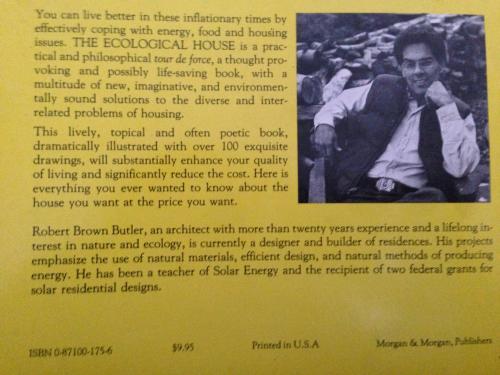
Mike Oehler is an original Idaho hero of all things underground since 1970. A good resource (as well as his honesty and humour - lots of laughs) is The Earth-Sheltered Solar Greenhouse Book: how to build an energy-free year-round greenhouse. It's "grudgingly dedicated to the gophers of America - honorable adversaries." I've got the 2007 2nd edition.
It's at Amazon http://www.amazon.com/Earth-Sheltered-Solar-Greenhouse-Book/dp/096044640...
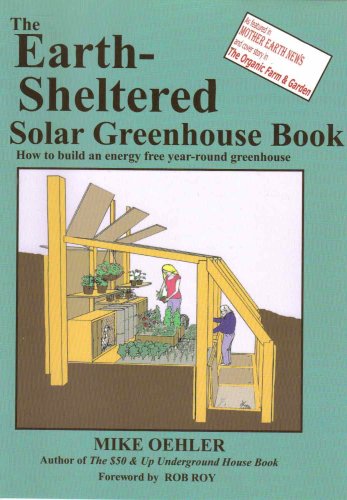
See also, Mike Oehler's original 1978 masterpiece The $50 And Up Underground House Book: how to design and build underground.The original gopher encounters. At Amazon also.
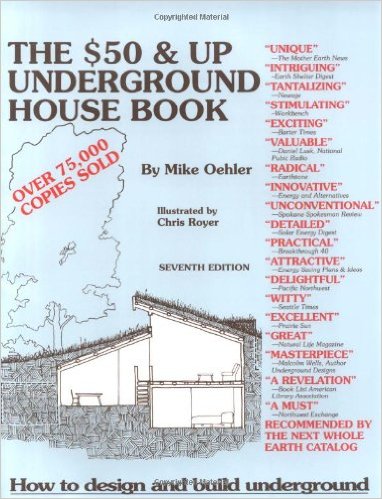
That's probably enough babbling from me on this for now. I look forward to hearing from you: the real experts and any other folks like me who want to learn.
Peace be with us, if we work for it with peaceful hearts,
gerrit


Comments
OMG!!!!!
I am so grateful for this!!! Raggedy Andy and I are planning a greenhouse and this is ideal! I can't wait to show him this essay tonight. Thank you so much, gerrit!!!!!
"The “jumpers” reminded us that one day we will all face only one choice and that is how we will die, not how we will live." Chris Hedges on 9/11
You're very welcome, RA :-) I'd be happy to hear his thoughts
on these things. I'm so pleased to find other folks interested in the same things. I've got lots to learn myself before we build. I don't know what vintage the Raggedy Family are, but I so enjoy all the 70s stuff becoming so relevant.
Resilience: practical action to improve things we can control.
3D+: developing language for postmodern spirituality.
I'll let you know his thoughts!
We are in our 50's and 60's! We have solar and wind generation, a small inside garden where he grown microgreens, and a mess of other greens, wheat grass, and will start our outside garden's seedlings in the basement. We want to be as self-sustaining as possible. We used to have chickens for the eggs (we don't eat meat), but we were going to move and now we're not, so we're going to get more chickens this spring.
"The “jumpers” reminded us that one day we will all face only one choice and that is how we will die, not how we will live." Chris Hedges on 9/11
Oh yes, we're decades-long vegetarians. Lovie sometimes eats
duck eggs and she does eat fish. Give some thought to ducks. Their eggs are different from those of chickens - more digestible and whatnot. She's pondering about how to raise fish in a future pond, but I know zip about that.
BTW, a favourite memory of mine: Quebeckers are the most avid meat-eaters I know. I once asked at a mess hall, "What are the vegetarian options?"
The cook looks at me strange and says, "Do you eat fish?" I says to him, "On what planet is a fish a vegetable?"
Resilience: practical action to improve things we can control.
3D+: developing language for postmodern spirituality.
If you want to raise fish,
look into aquaponics...
Please help the Resilience Resource Library grow by adding your links.
First Nations News
Ah, I really must get up to speed on this: it's a two-fer. Thank
you, Martha. And thanks for reading the article. I usually only discuss these things with my family, so it is really cool to be with folks with whom I could talk about resiliency. We're all in this together, eh. Best wishes,
Resilience: practical action to improve things we can control.
3D+: developing language for postmodern spirituality.
You're in good company....
http://caucus99percent.com/content/i-am-green-witch
Please help the Resilience Resource Library grow by adding your links.
First Nations News
w00t! Someone who also reads the Archdruid! I missed your
article - I was MIA for 10 days with a ptsd spell of, um, uncommunicability. I like c99 and will try to come back every time. But I missed out on your article full of wisdom and knowledge. Thanks for the link. JMG is a genius. When is he back from his big break? I know zip about druiding and wizardry, but I'm all ears on app tech and civilizational collapse. As an emergency Manager, you've probably read Jared Diamond and, argh, Russian fellow, ah, Dimitri Orlov.
Speaking of relevant knowledge, as an EM you're chock full of the good stuff :=) Like the sunlight water filtration unit. Are we ever fortunate you're here. I'm so half-English, the typical enthusiastic amateur, but you actually know stuff. This is a good thing. I hope you would write more articles as time and energy permit. (Dancing a little jig.) Cheers,
Resilience: practical action to improve things we can control.
3D+: developing language for postmodern spirituality.
Oh my!!!!
*ROFL*....
Please help the Resilience Resource Library grow by adding your links.
First Nations News
Right on! I saw in your comment to DMW that he knows about
PTSD too. If you folks also make homebrew, we're probably related! Down the road I'll write about our plans for building an earthship for the kids. Now, that is beyond cool. We bought the floor plans and are saving up for a rural property. We'll live in the existing house and we'll help the kids build their earthship. They want to use it as an income-generating thing also by doing some eco-tourism hosting. Ask Andy if he knows the concept. It started (well, millennia ago :=) in Arizona and our plans come from a Canadian family who have customized the design for our climate. Plans, plans, plans. More execution, G! Best wishes, RA.
Resilience: practical action to improve things we can control.
3D+: developing language for postmodern spirituality.
Gerrit - RAndy read the diary
and comments. We were cracking up. He said, tell him we are somewhat related, (second cousins once removed) we make homegrew.
We like your underground greenhouse. He's been thinking and researching something along those lines as well. We have quite a few acres and can do pretty much whatever we want. We'd like something like a cellar, but with the greenhouse top. Anyway - another worthwhile project to pursue!
(edited for typo)
"The “jumpers” reminded us that one day we will all face only one choice and that is how we will die, not how we will live." Chris Hedges on 9/11
Morning, Cousin RA :=) The cellar/greenhouse combo sounds
really cool. When you get there, I'd be interested to see some photos of the construction to be able to visualize how you work the cellar in under the greenhouse. I'm hoping to get to the homegrew myself when we move to our acreage. I've heard so many good stories of how it helps folks and I'd prefer to get natural help over these concocted chemicals. Please give my best to Cousin R.Andy and have a great day.
Resilience: practical action to improve things we can control.
3D+: developing language for postmodern spirituality.
I'll do it, CuzG!
We're a year or two away from that dream. We're starting a garlic patch to use as a cash crop to fund our endeavors. It takes a few years to get where you are actually selling and making real money. We started out with about 50 plants, which we then used as seed garlic, a couple years ago. We've got 425 this year, which should parlay into 2,000 or so next year. That's when things will really get going!
We find the homegrew to be a huge help in the struggle to realize done type of normalcy in this abnormal life.
So good to find you, dear cuz!
"The “jumpers” reminded us that one day we will all face only one choice and that is how we will die, not how we will live." Chris Hedges on 9/11
Garlic is a good cash crop. We have friends who homestead
and they have grown their garlic business from the ground up. It's like you say, it does take a few years, but it has better profit margins than most. I hope you have osme woodland on your property, because wild garlic has even higher profits. (There's some really funky profits to make from woodlands :=) They also run a CSA, which way too much work for any sane human! We love them; they're also real renewable energy wizards and we learn so much from them.
I'm just delighted to have discovered new distant relatives!
Resilience: practical action to improve things we can control.
3D+: developing language for postmodern spirituality.
Walipini greenhouses
Actually, it is after reading a Raggedy Ann post about putting shipping containers underground, that I discovered the Walipini concept. They are underground greenhouses that are inexpensive to construct.
In north central Texas, I think these are a solution for us. However, instead of running east to west, I think I am going to construct one that is north to south.
Our main problems here are extreme heat in the summer, short growing seasons, and attacks from insects. The underground greenhouse will help us in all of these areas. Right now, in my part of Texas, it is pretty much impossible to grow your own food. The short growing seasons and violent insect pests prohibit gardening.
Marilyn
"Make dirt, not war." eyo
Thanks, mhagle, I hadn't heard of the Walipini greenhouse. I'll
look it up today. Cheers, mate
Resilience: practical action to improve things we can control.
3D+: developing language for postmodern spirituality.
Pit / Walipini Greenhouses
Last month I mentioned my plans to expand my garden to my daughter, & she emailed me this inspirationgreen.com link. Lots of nice pictures & more links to other online sources.
I'm not really up to such an ambitious project right now, but they look like just the thing for someone really interested in food self-sufficiency.
We're planning on moving to PA this summer,
and this looks like it would work beautifully there. So this is perfect timing, thanks very much!
Hell is empty and all the devils are here. William Shakespeare
Important ideas here
It's clearly not a good idea to count on an ongoing supply of boundless extractive-based energy, so what makes more sense than energy conservation and passive solar?
I live in the southwest, why doesn't everybody have adobe houses? You don't even have to deal with flooding issues so much with those. This culture is so insanely profligate. Doesn't have to be that way.
Stay on track. Stay in lane. Don't throw rocks.
A couple of thoughts
that you will probably not get from other sources.
1. Extreme weather. The whole point of this is to continue to grow food when weather precludes standard agriculture. Being Earth sheltered helps mitigate temperature fluctuations, but you also need to consider flooding (20 inch rainfall, this is below grade after all), hail (even if it is uncommon in your region now, normal weather is over forever), and very high winds. Make sure your design accommodates bolting on 3/4 inch plywood panels or something similar to protect the glazing (assuming you have advance warning of a storm). The whole structure needs to be able to withstand 100+ mph winds, not typical flimsy greenhouse construction.
2. Water supply. What if you don't have one? If you are on a well, what happens when your water table drops? If you are on a city water line, what do you do when they ration water? Integrate water storage into your design (it can act as additional thermal mass, and your greenhouse should never freeze). Size it to provide several days supply. The wealthy in Sao Paulo relied on cisterns and filled them when the water was on, drew them down when it was off. The poor used open containers like barrels and buckets and there was a surge in mosquito-born disease. Also consider rainwater capture from the glazed area. Believe it or not, rainwater capture is illegal where I live, but not most places. Be subtle. One storage tank for rainwater (unpressurized), the other for pressurized water from well or city line (don't forget check valves), with a way to switch the drip lines to the rainwater, and a sand filter to remove solids.
"The greatest shortcoming of the human race is our inability to understand the exponential function." -- Albert Bartlett
"A species that is hurtling toward extinction has no business promoting slow incremental change." -- Caitlin Johnstone
Interesting, Gerrit
I won't be able to build anything like this, but enjoyed learning/reading. Very cool. Thank you.
Thanks for these pictures
I really love this stuff....by that I mean figuring out solutions to these various problems. One of the thing that I have always tried to do is to keep as light a footprint on this planet as possible. Anything and everything that can help with that is of interest to me. So I really appreciate your time on this. I am absolutely a neophyte with the technical aspects of said endeavor. My actions have consisted of things like hanging my laundry out on the clothes line, driving a small car, eschewing heat and air-conditioning as much as possible, etc.. So I am really in the position of taking my first baby step to doing something more substantial. I absolutely don't know what I'm doing in that regard.
I tend to think that self-sufficiency is something that we should aim for. Not for survivalist-type reasons but because I think that it is the best model going forward to promote a small footprint by everybody. I do see a mixture of both community hi-tech infrastructure and individual self-sufficiency as a way to get the best of efficiency and low impact living.
Anyway, thanks for the pictures and the inspiration. I and many others have a yuge learning curve ahead of us if we are going to pull something like this off. We will all need help from many quarters.
You're welcome, rand, and I have good news on the technical
side. I started off in the same position as you, but I'm learning. My father died young and I had no one to show me practical skills. I began with acquiring tools mostly used and just practiced by doing small projects. For example, get a straightforward plan for a workbench, figure out which tools are needed, buy the wood, and just build it. (I'm assuming an available space like a garage or basement.) So then you have a workplace and a workbench where you could practice small projects. Like making a pair of sawhorses from 2x4s. Then you're able to take on bigger projects. And so on. It builds skills, knowledge, and most of all, confidence. While you gain those, you research the big stuff like a greenhouse and so on. Wherever you can, glean knowledge from the experts. They're so happy to share their hard-won knowledge, it's a real treat.
I hope that helps a bit. Just do it. It's the only way. I learn more from my mistakes than from getting it right. It's great to discuss these things with you. Best wishes, mate
Resilience: practical action to improve things we can control.
3D+: developing language for postmodern spirituality.
Thank you!
That is just my speed. Start small and try and build on each newly-aquired skill. Appreciate your suggestions and experience.
Morning, WD, thanks for those two valuable points. They're
crucial factors. We've given lots of thought to water security issues (I'll try to put something together about resources for learning and planning water security.) But the future wind factor is new to me. I've understood the notion in an, ahem, airy sort of way, but it hadn't come home to me until I read your comment.
The future will be storm-tossed. We have bought plans for an earthship, which two of our kids want to build and live in. It institutes built-in solutions to the water question and it's terrain management features helps with diverting storm water run-off. My first thought is that the design will stand up to hurricane strength winds, but I obviously need to go pore over those again. As for the underground greenhouse, yes, I'll have to talk with Mr Finch about flood and wind before building. So, thank you, thank you, thank you!
Your point makes me think now about how such elevated, sustained, and persistent wind strength would impact ALL the structures on a farmstead. In my youth I experienced big sandstorms in the Kalahari desert of Southern Africa. Um, everything stops, nothing works, and it takes days to dig stuff out and clean equipment that wasn't perfectly sealed with protective covers. I can taste the red grit again :=) Dang it! I'd have to use those experiences and that of some other bloody deserts to think hard about wind and dust.
We are so f*cked.
Resilience: practical action to improve things we can control.
3D+: developing language for postmodern spirituality.
Good morning, G
One of the predictions for the interiors of continents is that they will become deserts and big dust bowls (with occasional flash floods). Also, a 2 C world average means 5-7 C average in the interior, with greater severity of extreme heat events. You are in Ontario, yes? Should not be as bad there, and you should be downwind from the Great Lakes, and thus more moist.
Where I live in SW Colorado we already have dirt storms every spring. I was driving in one, alongside a freshly plowed field, and I couldn't see the end of the hood.
Surface life will be problematic.
To the extent that there is any hope for a future, I'm thinking about a concept I'm calling "Earth bases", a terrestrial equivalent of a science fiction Mars base. The Earth, even in a full-blown Jurrasic Park climate cycle would never be as inhospitable as Mars, but it doesn't need to be to preclude human life. Think of a city mostly underground, with big skylights that can be protected from winds and hail. Underground greenhouses, fully enclosed aeroponic/LED lighted grow ares for greens and such. Offshore, floating wind-powered desalination plants with fresh water pipelines leading to shore. A population large enough to maintain post-modern technology, with a focus on scientists, engineers, and technicians. Probably lots of robots. Total population, worldwide, in the low 100s of millions. All powered by renewable energy that can be hardened against mega storms. Outdoors work requires something like a hazmat suit with an air conditioning unit. If your suit fails you are probably dead in minutes. You would probably need supplemental oxygen (die-off of phytoplancton reduces oxygen production), and who knows how long it takes for Canfield oceans to develop (SO2 storms). The cities would also need supplemental oxygen, but would probably not need to be airtight. Unless all the 400+ nuke plants go Fukushima and you need to protect from radiation as well. And they better be located more than 220 feet above current sea level.
Humanity would have to make these sorts of cities home until we can geo-engineer the planet back to a habitable range, and re-establish viable ecosystems. Centuries certainly, probably millennia.
And we better have this up and running in 20 years or there won't be enough people left to save.
"The greatest shortcoming of the human race is our inability to understand the exponential function." -- Albert Bartlett
"A species that is hurtling toward extinction has no business promoting slow incremental change." -- Caitlin Johnstone
It's grim, but you are probably right
I believe we need to confront disastrous weather prospects and hope for the future in the same effort. We have to prepare for the worst, and engineer for the best (away from fossil fuels to renewables).
Marilyn
"Make dirt, not war." eyo
Moral Side vs "Other" Side
By choosing roles in the story of climate change, we have been shooting the metaphorical foot of the human race.
Putting moral (per me) goals and political (per me) goals (ahead of science and saving the civilization) might feel good, but really. Isn't this time to - not forgive - but to excuse the past and to forget the emotional past? Big-Orange 'debate' often turns out to be a lecture. And right now, the hue of the climate debate has an "orange" tint - if you know what I mean.
And if some of you folks want to start a group to save the human race, give a shout. I can be found at Midnight Mulling, most nights.
best, john
Strange that a harp of thousand strings should keep in tune so long
Hi john! It's good to meet you. We need lots more discussion
of what to do. Honest, open, friendly, and most of all, practical discussions of how-to. Best wishes,
Resilience: practical action to improve things we can control.
3D+: developing language for postmodern spirituality.
I don't know if I understand
exactly what you are saying. ???
The climate change issue is really complicated because, which is more important? 1) We fight to change what our government is doing? 2) We change what we are doing personally? 3) We change what we are doing as a community? 4) What does this mean for us personally/politically? 5) All of the above?
I view climate change as the most important political issue of our time. Mostly because I have personally experienced extreme climate complications . . . 1) Losing hundreds of trees around our home in one month to the Mexican Soapberry Borer Beetle 2) Getting 20 inches of rain in 48 hours 3) Because of the Polar Vortex the growing season for vegetables was reduced to a month
I moved to Texas in 1992. While I discovered that the soil was crappy, I still had a pretty decent garden for years. I heavily depended on irrigation and Miracle Grow. That has all changed now.
Maybe my expectations are too high. I grew up on an organic dairy farm in Iowa. We raised all of our own food.
With the new climate situation, it seems like we need to be able to raise our own food again. Without a solution like underground greenhouses in Texas, we cannot raise our own food.
Marilyn
"Make dirt, not war." eyo
Great points, Marilyn, and yes, we all now have to learn how
to grow food indoors and below ground. And it's a big job because first we have to build structures strong enough to resist the storms, and then we have to learn how to grow things indoors in containers. We have to learn each plant's needs real well to help them grow in an unnatural environment. I can't just plant seed and seedlings in our garden and let them go. I will have to get good at daily monitoring and whatnot. Yikes. That's a lot of work. I've recently made a 4x2x2 ft cedar waist-high planter box to experiment growing indoors under a 4-ft grow light. First, just salad stuff, but I'd better get up to speed quickly. Martha reminded me on this thread of hydroponics. Lots to learn, eh. I'd like to hear how things go there in TX as you figure stuff out. Your climate is a lot worse than ours in Ontario and yours is worsening at a faster rate than up here. Thanks for this, eh.
Resilience: practical action to improve things we can control.
3D+: developing language for postmodern spirituality.
Yo, best, John, a Question:
A. How can global climactic change occur, without a galactic cash register?
B. If temps are increasing, why do we keep paying too much for permanent staff?
C. what is the bestest way to identify a flat earth, climate change ignoring, neoCon, Christian politician?
D. Which planet next?
Now that describes the future better than anything I've seen
in any media stories.
And your timeline is correct: if such habitation domes aren't established by then, there won't be even remnants of humanity or other species left. And I think that the reason why the elites aren't leading us to climate solutions is because they will have the resources to build domes and secure them against the rest of us climate refugees.
Your description of the domes' requirements sound really viable to this non-engineer. When my kids and us talk about the future, I say to them that they will raise their children mostly underground and they get it. They do. But your dome description makes me understand that more.
I have thought that our family plans for climate resiliency were fairly radical when compared to the average lower-middle class family. Perhaps they aren't radical enough. When the kids move in in a month, we'll have to see the "homesteading acreage with earthship and underground greenhouse as only a first step. Diggety, dig, dig! On that point, here's a clip of a song my son the game programmer showed me and it might be appropriate :=)
But seriously. On the underground greenhouse and the problem of hurricane winds, I'm thinking that job one is to site the greenhouse with the north wall bermed, as in an earthship construction, or built into another strong structure. Then on the south, polycarbonate side, we'd have to install a protective screen, such as folks do in hurricane areas, perhaps on on rails that could slide in to lock and protect real fast. Because the storms would include not just those that build up, but also those that swoop in fast, such as tornadoes (which are increasing here in southern Ontario.) And the danged dust, which you see building up in your area.
I think I'll do an article for next weekend on the earthship concept so folks could form an idea. It would help me to think it through in terms of short (3-year) and intermediate (10-year) time frames. As your points make me realize now, we have to think of much deeper and of domes to build for the longer term - the grandkids and whatnot. In our family situation, we couldn't possibly make such a scale, we'd have to build a community. Thankfully, the kids are the doers and I'm learning how to be an elder. Our earthship engineer builds these things for and with clients all over Canada. He'll help the kids assemble a work party from volunteers who want to learn how to build. (Lovie and my job will be to house and feed the hordes!) Our kids would have to have serious discussions with their peers and friends to find those with the skills and personal balance to work together on "deeper and doming" - there's my new slogan :=)
I so appreciate bieng able to think at stuff with you. Thank you.
Resilience: practical action to improve things we can control.
3D+: developing language for postmodern spirituality.
"Thankfully, the kids are the doers and I'm learning how to be
Ish, the Hammer."
"I’m a human being, first and foremost, and as such I’m for whoever and whatever benefits humanity as a whole.” —Malcolm X
Back when I was young and stupid,
I was a framing carpenter (I have done a lot of different things in my life, all of which dovetailed nicely one into the other) so I love learning about building things in new ways. I hated stick framing. It always seemed such a huge waste to me...
So, from my Green Witch library let me recommend;
The Tire House Book by Ed Paschich and Paula Hendricks
Living Well on Practically Nothing by Edward H. Romney
And an oldie but a goodie... (Mine is pretty old, but there is an updated version) The Reader's Digest Complete Do-it-yourself Manual
Please help the Resilience Resource Library grow by adding your links.
First Nations News
Ooh, the tire house looks good. My kids are gonna build an
earthship on our next property. It sounds just like the Tire House book. Our earthship engineering contractor uses goodness knows how many tires in the walls of the earthship. We'll stack the tires in rows inside all the earthen walls. The tire stacks are filled with cement and then we'll ram the earth for the walls. In his own earthship home and that of his folks, the walls are just massive. Takes a bit getting used to, cause they're not neat and straight like the drywall on stick buildings (don't like them either.) I'll work on an earthship article for next weekend with some photos.
The Living Well book makes me smile. Our family are experts on living well on practically nothing. I came to Canada as an immigrant with a backpack. Our resiliency book rack has lots of how-to books on being poor, all from Sally Ann stores over the years. The nifty tricks and ideas in them have helped us lots over the years. And I have the same RD DIY manual. It is still much better than most any other DIY book I've seen. I'm going to get the tire book for sure.
Don't get me started on "when I was young and stupid" :=) You know, it is funny though, when I look back through the wreckage, I see that it could not have been any other way. All the disparate pieces now form an intricate whole, like a quilt made from scraps of cloth. A framing carpenter, eh. I wish that had been on my menu of options back in the day! That skill would come in handy. Thanks for all the good advice.
Resilience: practical action to improve things we can control.
3D+: developing language for postmodern spirituality.
You're in Canada?
Where? I'm in Ontario...
Please help the Resilience Resource Library grow by adding your links.
First Nations News
Really? Cool. I'm in a village 45 mins east of Ottawa called
Casselman. About 1,500 people. Where are you?
Resilience: practical action to improve things we can control.
3D+: developing language for postmodern spirituality.
I'm in "The Hammer" Hamilton,
about an hour south of Toronto.
Please help the Resilience Resource Library grow by adding your links.
First Nations News
Morning Martha. I know Hamilton. I used to play rugby in
Burlington for the Centaurs club and traveled up and down Niagara on weekends for games, until the Centaurs switched leagues to play in the $%^&* Toronto league. Lovie's family is from the Milton area and we lived there for 5 years or so. Friends of ours lived in Hamilton in one of those impossibly skinny, tall red brick houses. Have a great day, eh.
Resilience: practical action to improve things we can control.
3D+: developing language for postmodern spirituality.
Rugby player too?
What next? Scrummy or Wing? I was a prop.
"I’m a human being, first and foremost, and as such I’m for whoever and whatever benefits humanity as a whole.” —Malcolm X
LOL! We must be related: I played flanker in the scrum. All
through primary and high school I binded onto my old mate, Foxie, who played prop. When we graduated, Foxie said that he'll forever have a Gerrit dent in the back of his right upper leg from my shoulder :=) Rugby is a great game. My youngest daughter plays in a new, development programme in her high school and May/June is so much fun. I go to every practice and game with my deck chair and cheer on the kids.
Resilience: practical action to improve things we can control.
3D+: developing language for postmodern spirituality.
I only played a couple of years
at the Academy. I loved it. If I wasn't so old and frail...
My old hooker flies at the airline with me. His Air Force call sign was "Stump".
"I’m a human being, first and foremost, and as such I’m for whoever and whatever benefits humanity as a whole.” —Malcolm X
I so wanted to play rugby in an "Golden Oldies" league, but my
back is fooked from 20 years of army backpacks and navy steel ladders :=( The MRI is not pretty. Oh well, life. That's a hoot that your old hooker is still a mate. Rugby is one of the few sports that truly fosters camaraderie, not only within a club, but also with opponents who share a meal and a pint in the clubhouse after a match, and anywhere one goes. It is growing in Canada, along with soccer. All you need are a field of grass, shorts, mouth guard, and a pair of cleats. Football and hockey, sadly, is expensive and, oddly, armoured. They promote cowardice instead of courage.
Resilience: practical action to improve things we can control.
3D+: developing language for postmodern spirituality.
I doubt that I will ever get up your way,
but if you are ever here, give me a shout and we will have some dinner or something.... Us Expat-Yanks need to stick together....eh?
Please help the Resilience Resource Library grow by adding your links.
First Nations News
Right on! We'll do that should I ever venture near the Big Smoke
again :=)
Resilience: practical action to improve things we can control.
3D+: developing language for postmodern spirituality.
Me too. Who woulda thunk?
Me too. Who woulda thunk?
Ya miter tried a different profession.
I love the character of steel. My front yard has several origami steel statues sitting there.
Due to one neighbor's Christian insensetivities, I had to move the 6 foot erect gargoyle, who happened to be, er, erect.
Steel can be rough, smooth, raw, hard, flexible, easily shaped, hammered, besotted, and totally bent. Or forged in heat and welded to others. It is a magical media. I love it as much as I love sketching on the iPadPro.
Steel rules! Which are pretty accurate at room temps.
I tried to learn to weld...
my eyes are just too light sensitive even with the darkest glass we could find for my helmet.
But I would LOVE to be able to do this.... (this was on display at a local garden center. It finally sold last year for a lot of $$$)
Please help the Resilience Resource Library grow by adding your links.
First Nations News
Great post great comments
Who a thunk so many here are on the same page regarding our future sources of food. I guess great minds do think alike.
Some really good points here and something tells me this is just the tip of the iceberg. The winds, the water supply, the potential flooding are all important issues we will face. Some of my own concerns involve rampant insect invasions as a result of predator extinctions ( frogs as one example ) and maintaining a productive growth medium ( formerly supplied by petroleum fertilizers ). Presently I'm experimenting with duplicating an ancient So. American man made soil called Terra Prieta.
Can we create groups here to focus those of us interested?
Neither Russia nor China is our enemy.
Neither Iran nor Venezuela are threatening America.
Cuba is a dead horse, stop beating it.
Oh! I have been FACINATED
with Terra Prieta!
And if you took this ancient soil improvement technique, and applied it to Square Foot Gardening... the possibilities just boggle the mind!
Please help the Resilience Resource Library grow by adding your links.
First Nations News
Thanks, earthling, Terra Prieta, eh? I gotta look this up. And
I'm with you in fostering discussion of the primary issues: resilience, self-sufficiency, and sustainability. I don't know how groups work on c99, but I'm real happy to post on climate and resiliency at least every weekend for us to discuss. The more of us who could contribute on these topics, the better, so have at it whenever you feel it.
Yikes, insect invasions...Sigh, yes, of course. All the more reason, I guess, to grow plants indoors from here on out. It's great to meet you here. Best wishes,
Resilience: practical action to improve things we can control.
3D+: developing language for postmodern spirituality.
"at least every weekend for us to discuss..."
Count me in. We've been planning an underground greenhouse for a while.
"I’m a human being, first and foremost, and as such I’m for whoever and whatever benefits humanity as a whole.” —Malcolm X
Bisbo, that is great news. Could you describe the general plan
for us? I dunno: a quick response or if you have time a little article? Then we could all learn stuff together. Woods Dweller taught me so much above in the thread. I'm kinda delirious to have fought folks who think like me. Bit of a recluse, I have become. You know...
Resilience: practical action to improve things we can control.
3D+: developing language for postmodern spirituality.
We have that "Earth Sheltered Solar Greenhouse" book
so the design looks pretty much just like the front cover. Probably a combination of cinder blocks and rocks, for structure, though. I have an awesome stonemason here in town, doing a bunch of work on our new place.
We live on a tiny lot, in Bisbee, old Craftsman house. Straw bale vegetable garden in the front yard because the back is way too small. Trying to move out of town, more room to grow food. Seven acres, adobe house, metal roof, great neighbors. LOTS of rocks. It's going to take some heavy equipment just to dig a hole, I am afraid.
You might be interested in my partner's blog. She has let it go for the last year, as she became the grassroots Bernie campaign in our county. The link is http://thedirtioccupy.blogspot.com/ Start at the bottom and work up.
"I’m a human being, first and foremost, and as such I’m for whoever and whatever benefits humanity as a whole.” —Malcolm X
WOW!
What BEAUTIFUL veggies! Thanks for sharing that... I have added it to my list of regular visits...
Please help the Resilience Resource Library grow by adding your links.
First Nations News
Oh cool, Bisbo, I'm checking her blog now: beautiful stuff. Ta'
Resilience: practical action to improve things we can control.
3D+: developing language for postmodern spirituality.